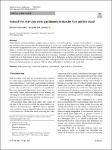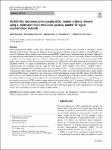Search
Author
- Jorgensen, Ed (3)
- McFadyen, Ron (3)
- Nora, El-Rashidy (3)
- Christian, Homeyer (2)
- next >
Subject
- programming (10)
- Open Access (8)
- Java (7)
- Programming (7)
- next >
Date issued
- 2020 - 2025 (293)
- 2010 - 2019 (39)
- 2000 - 2009 (2)
- 1999 - 1999 (1)
Has File(s)
- true (335)
Search Results
Passwordless authentication is a trending theme in cyber security, while biometrics gradually replace knowledge-based schemes. However, Personal Identification Numbers, passcodes, and graphical passwords are still considered as the primary means for authentication. Passwords must be memorable to be usable; therefore, users tend to choose easy to guess secrets, compromising security. The Android Pattern Unlock is a popular graphical password scheme that can be easily attacked by exploiting human behavioristic traits. Despite its vulnerabilities, the popularity of the scheme has led researchers to propose adjustments and variations that enhance security but maintain its familiar user interface. |
In recent years, the field of natural language processing has seen substantial developments, resulting in powerful voice-based interactive services. The quality of the voice and interactivity are sometimes so good that the artificial can no longer be differentiated from real persons. Thus, discerning whether an interactional partner is a human or an artificial agent is no longer merely a theoretical question but a practical problem society faces. Consequently, the ‘Turing test’ has moved from the laboratory into the wild. |
Aiming at solving the problems of low success rate and weak robustness of object tracking algorithms based on siamese network in complex scenes with occlusion, deformation, and rotation, a siamese network object tracking algorithm with attention network and adaptive loss function (SiamANAL) is proposed. Firstly, the multi-layer feature fusion module for template branch (MFFMT) and the multi-layer feature fusion module for search branch (MFFMS) are designed. The modified convolutional neural networks (CNN) are used for feature extraction through the fusion module to solve the problem of features loss caused by too deep network. |
Customer churn is a major issue for large enterprises. In particular, in the rental business sector, companies are looking for ways to retain their customers because they are their main source of revenue. The main contribution of our work is to analyze the customer behavior information of actual water purifier rental company, where customer churn occurs very frequently, and to develop and verify the churn prediction model. A machine learning algorithm was applied to a large-capacity operating dataset of rental care service in an electronics company in Korea, to learn meaningful features. To measure the performance of the model, the F-measure and area under curve (AUC) were adopted whereby an F1 value of 93% and an AUC of 88% were achieved. |
Hearing loss is one of the most prevalent chronic health problems worldwide and a common intervention is the wearing of hearing aids. However, the tedious fitting procedures and limited hearing experts pose restrictions for the popularity of hearing aids. This paper introduced a hearing loss classification method based on the insertion gain of hearing aids, which aims to simplify the fitting procedure and achieve a fitting-free effect of the hearing aid, in line with current research trends in key algorithms for fitting-free hearing aids. The proposed method innovatively combines the insertion gain of hearing aids with the covariates of patient’s gender, age, wearing history to form a new set of hearing loss vectors, and then classifies the hearing loss into six categories by unsupe... |
Video2Flink is a distributed highly scalable video processing system for bounded (i.e., stored) or unbounded (i.e., continuous) and real-time video streams with the same efficiency. It shows how complicated video processing tasks can be expressed and executed as pipelined data flows on Apache Flink, an open-source stream processing platform. Video2Flink uses Apache Kafka to facilitate the machine-to-machine (m2m) communication between the video production and the video processing system that runs on Apache Flink. Features that make the combination of Apache Kafka and Apache Flink a desirable solution to the problem of video processing are the ease of customization, portability, scalability, and fault tolerance. |
This open access book presents the outcomes of the “Design for Future – Managed Software Evolution” priority program 1593, which was launched by the German Research Foundation (“Deutsche Forschungsgemeinschaft (DFG)”) to develop new approaches to software engineering with a specific focus on long-lived software systems. The different lifecycles of software and hardware platforms lead to interoperability problems in such systems. Instead of separating the development, adaptation and evolution of software and its platforms, as well as aspects like operation, monitoring and maintenance, they should all be integrated into one overarching process. Accordingly, the book is split into three major parts, the first of which includes an introduction to the nature of software evolution, follow... |
Networks of splicing processors are one of the theoretical computational models that take inspiration from nature to efficiently solve problems that our current computational knowledge is not able to. One of the issues restricting/hindering is practical implementation is the arbitrariness of the underlying graph, since our computational systems usually conform to a predefined topology. We propose simulations of networks of splicing processors having arbitrary underlying graphs by networks whose underlying graphs are of a predefined topology: complete, star, and grid graphs. |
Electroencephalogram (EEG) signals suffer substantially from motion artifacts when recorded in ambulatory settings utilizing wearable sensors. Because the diagnosis of many neurological diseases is heavily reliant on clean EEG data, it is critical to eliminate motion artifacts from motion-corrupted EEG signals using reliable and robust algorithms. Although a few deep learning-based models have been proposed for the removal of ocular, muscle, and cardiac artifacts from EEG data to the best of our knowledge, there is no attempt has been made in removing motion artifacts from motion-corrupted EEG signals: In this paper, a novel 1D convolutional neural network (CNN) called multi-layer multi-resolution spatially pooled (MLMRS) network for signal reconstruction is proposed for EEG motion ... |
Optimization is about finding the best available object with respect to an objective function. Mathematics and quantitative sciences have been highly successful in formulating problems as optimization problems, and constructing clever processes that find optimal objects from sets of objects. As computers have become readily available to most people, optimization and optimized processes play a very broad role in societies. It is not obvious, however, that the optimization processes that work for mathematics and abstract objects should be readily applied to complex and open social systems. In this paper we set forth a framework to understand when optimization is limited, particularly for complex and open social systems. |









